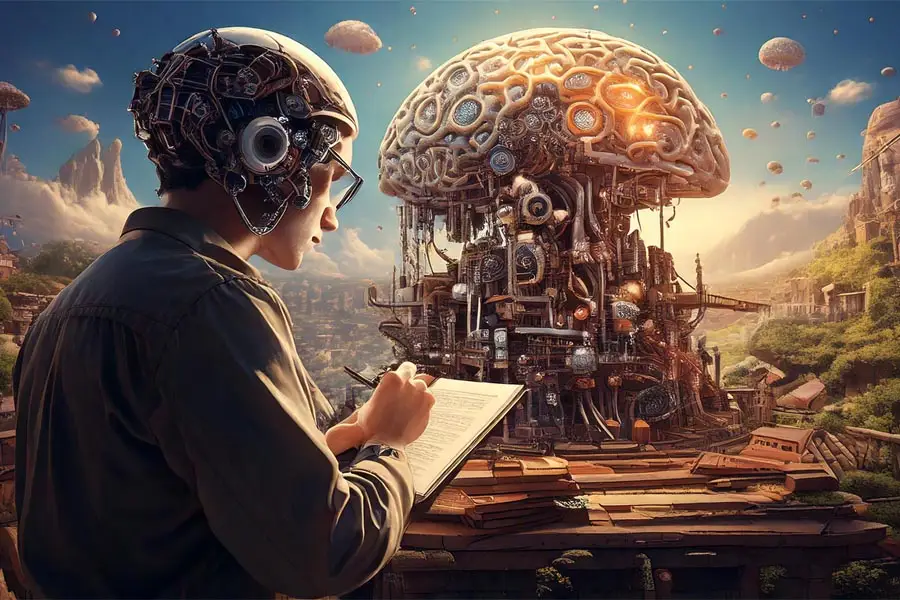From smartphones to self-driving automobiles, artificial intelligence (AI) is a distinguishing feature of the twenty-first century. However, the development of AI as a major component of contemporary life has taken decades, influenced by advances in cognitive science, computers, and mathematics. Let us examine the development of artificial intelligence from its inception as theoretical ideas to the revolutionary technology it is today.
1. The Origins: Early Concepts and Foundations
The idea of artificial intelligence has been around for millennia, with the oldest theories coming from mathematics, philosophy, and logic. Here are a few significant turning points:
- Antiquity to the 19th Century: Philosophers like Aristotle explored logic, which laid the groundwork for reasoning in AI. During the 17th century, philosopher and mathematician René Descartes speculated on machines that could think.
- 1800s and Early Computing Concepts: The foundation for thinking in AI was established by the study of logic by philosophers such as Aristotle. René Descartes, a mathematician and philosopher, made conjectures about thinking machines in the 17th century.
2. The Dawn of AI (1940s–1950s)
The emergence of artificial intelligence was facilitated by the advent of digital computers in the middle of the 20th century. Among the noteworthy developments were:
- Alan Turing and the Turing Test: The Turing Test was developed in 1950 by British mathematician Alan Turing to assess a machine’s capacity for intelligent behavior that is indistinguishable from that of a person. Scientists and engineers were inspired by Turing’s theories on “thinking machines.”
- Birth of AI as a Field: John McCarthy, Marvin Minsky, and others organized the Dartmouth Conference in 1956, which officially acknowledged artificial intelligence as a separate field of study. The phrase “artificial intelligence” was first used by McCarthy at this meeting, which officially marked the beginning of AI.
3. The Early Days and Symbolic AI (1960s–1970s)
For AI researchers, the 1960s and 1970s were hopeful years. Symbolic AI—systems that mimicked the logical mind by manipulating data using symbols and rules—was the emphasis of AI research throughout these years.
- Early Successes: Early AI’s potential in natural language processing and scientific problem-solving was shown by programs like DENDRAL (1965), chemical analysis software, and ELIZA (1966), a basic chatbot.
- Funding and Research Boom: Governments recognized the potential of AI, especially in the United States, and provided funding for studies in computer vision, robotics, and automated translation.
But as soon as the limitations of symbolic AI were apparent, expectations started to rise faster than advancements.
4. The AI Winter (1970s–1980s)
Funding dried up, and AI development entered what is known as the AI Winter as the technology failed to live up to its initial promises. This decline was caused by two main constraints:
- Complexity and Scalability: Complex, real-world applications were difficult for symbolic AI to handle, and the systems relied on pre-programmed rules rather than learning from fresh input.
- Computational Limits: The intense processing power needed for sophisticated AI applications was beyond the capabilities of the hardware available at the time, which hindered advancement.
Despite this slowdown, some foundational work continued, particularly in machine learning, which would set the stage for AI’s resurgence.
5. The Rise of Machine Learning (1990s–2000s)
Machine learning (ML), a technique that lets computers learn from data rather than rigid rules, helped AI start to develop in the 1990s. During this time, significant occurrences included:
- Neural Networks Resurgence: Even though neural networks were first proposed in the 1950s, researchers were able to train multi-layered networks because of advancements in computing power. This resulted in advances in speech and picture recognition.
- Deep Blue vs. Kasparov: When IBM’s Deep Blue upset chess master Garry Kasparov in 1997, it generated headlines and demonstrated that computers could beat people at strategic, challenging games.
- Increased Interest in Data-Driven AI: Massive volumes of data were produced by the internet’s growth, which allowed AI systems to learn from enormous datasets and fueled advances in predictive analytics and data science.
6. The Deep Learning Revolution (2010s–Present)
Deep learning, a branch of machine learning that uses multi-layered neural networks, had completely transformed artificial intelligence by the 2010s. The success of deep learning was fueled by large datasets, improved algorithms, and potent GPUs. Important developments included:
- Breakthroughs in Image and Speech Recognition: In tasks like image classification (e.g., ImageNet competition) and speech recognition (e.g., Siri, Alexa), deep learning allowed AI to outperform humans.
- AlphaGo and Reinforcement Learning: AlphaGo, a Google DeepMind machine that used reinforcement learning to master one of the most difficult games on the planet, defeated the world champion Go player in 2016.
- Natural Language Processing: Natural language processing was revolutionized by sophisticated models such as BERT, GPT, and other transformers, which allowed AI to comprehend and produce prose that is similar to that of a human. Applications like chatbots, language translation, and content creation resulted from this.
7. Today’s AI: From Narrow to General Intelligence
The majority of AI systems in use today are narrow AI, meaning they are designed to carry out particular tasks like language translation or image recognition. Even though artificial intelligence (AI) has advanced significantly, it is still a long way from becoming a machine that can reason like a person on a wide variety of jobs.
Current AI research focuses on:
- Explainable AI: Transparent, interpretable AI systems are essential since AI is having a significant impact on industries like healthcare and finance.
- Ethics and Governance: Ethical issues and legal frameworks are essential to ensuring responsible and equitable use of AI as its power and breadth increase.
- Continued AI Innovations: The limits of artificial intelligence are being pushed by research in fields including robotics, natural language comprehension, and generative models (such as ChatGPT for conversation and DALL-E for image production).
Conclusion
AI’s development from philosophical conjecture to a game-changing technology has been characterized by cycles of hope, failure, and innovation. With the help of deep learning and enormous amounts of data, modern AI systems have accomplished amazing things. However, as researchers strive for more potent, accountable, and explicable AI, the path ahead is still difficult. Knowing AI’s past enables us to recognize both its amazing potential and the associated ethical issues as we look to the future.

